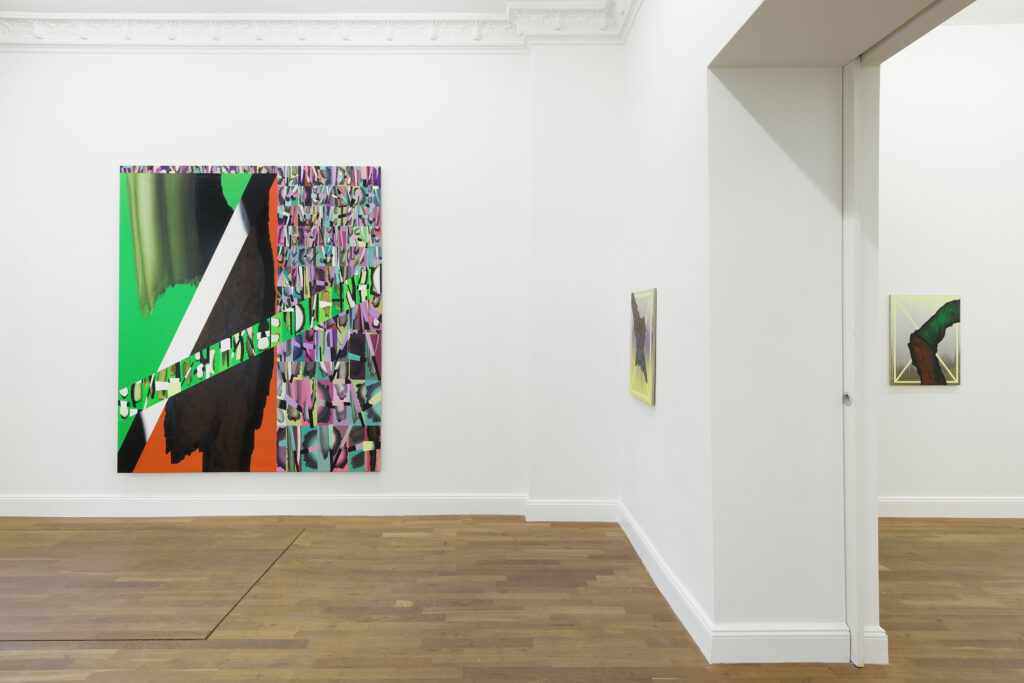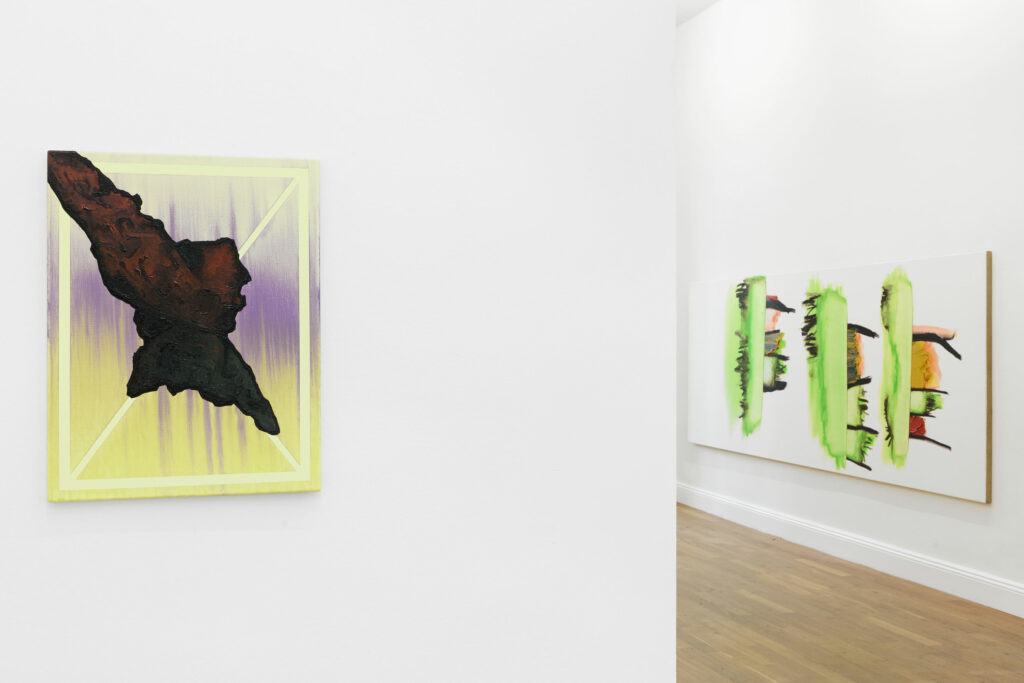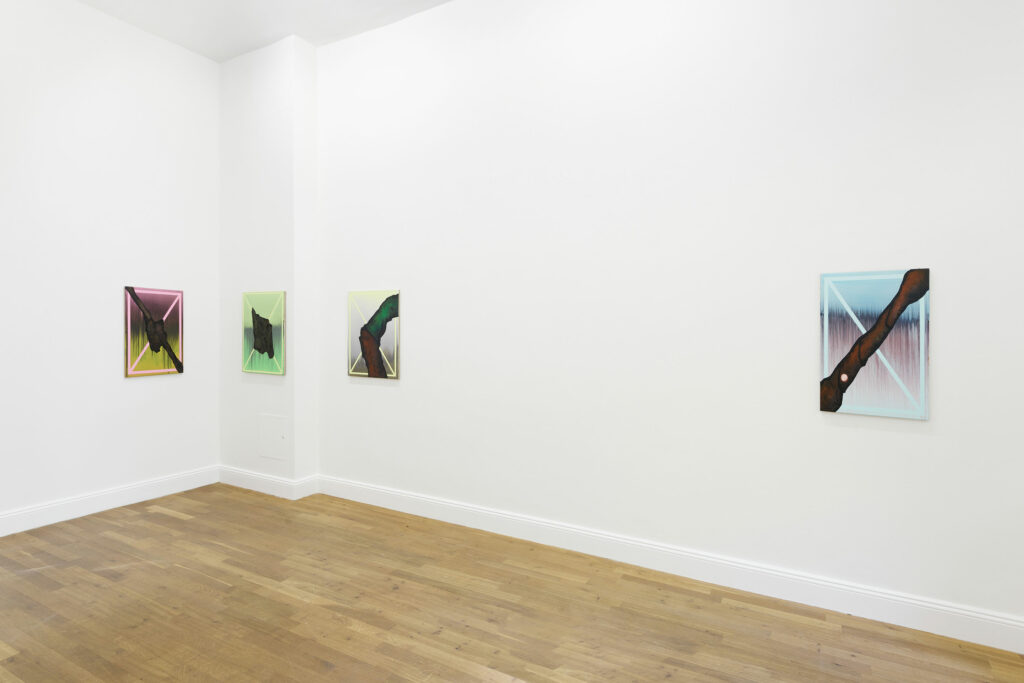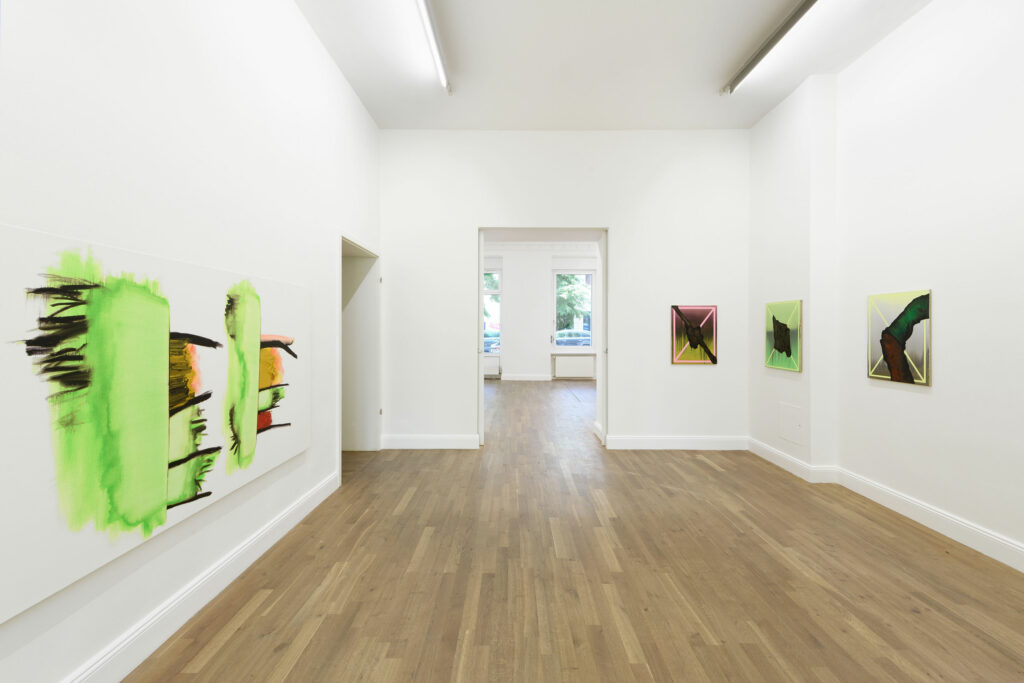Show 29
struldbrugs
Klaus Merkel
May 29 - August 28, 2021

Variations on No Theme.
The Insistence of the Work and the Painting of Klaus Merkel
Hardly any other aesthetic category appears more outdated at present than that of the work. The twofold immaterialization of artistic production through conceptual art and digitization has seemingly made the work of art obsolete as a material substrate and as a commodity. In addition, the theory of art has also turned away from it and toward the receptive aesthetic experience. A new category of the type already demanded by Walter Benjamin in the name of film or reproduction techniques in general, or by Umberto Eco with regard to a new openness of the concept of the work, or finally by Roland Barthes in conjunction with the transition from work to text, is, all the same, not in sight. As is the case in every transgressive logic, a beyond of the work remains a rather hollow promise that lives more from its premise than from its objective.
Perhaps, however, it is fundamentally too short-sighted to see only the material, the self-contained, the unique or the elite in the work of art and to try to contrast this in each case with something completely different. The question arises whether ‘the’ work in the specific historical form it has assumed since the seventeenth and eighteenth centuries does not represent a clearly more complex category. Its distinctiveness could lie precisely not in the determination of one-sided properties of certain objects, which then establish them as works of art, but in the production of a symbolic matrix, which can only be understood in the interaction of specific relational forms. That is, what makes a work a work is precisely the connection between the material and the immaterial, the closed and the open, the manifold and the uniform, the concrete and the absolute. Taken in this way, the immaterial, for example, is not to be understood as the overcoming of the work, but as part of its conditions. Today’s forms of the performative, the processual, the activist, or the conceptual would accordingly not fundamentally attest to the dissolution from the work, but merely to an accentuation of artistic productions that has only become possible through the work itself.
More important, therefore, than its hasty dismissal would be an understanding of the work as such a complex aesthetic category, undoubtedly full of, as Karl Marx puts it with a view to the commodity, ‘theological perversities.’ A genealogy of the work would accordingly have to explore its way through these theological, alchemical, or artisanal roots and their transformation into the cosmos of idealist philosophy. For the idea of the work not only concerns notions of a particularly skilful production, a genial creation, or a substantial transformation of everyday objects, but also in equal measure fundamental philosophical dispositions such as the suspension of the contingency of existence or a structural finality. Something thus always comes to a conclusion in the work. Only when it is completed does it become recognizable as a work and then finds its ‘necessity’ in it. Otherwise, it would remain piecemeal. At the same time, ideas of time and labour remain effective in the concept of work, such as the six days of God’s ‘work’ creating heaven and earth and thus elements that both affirm and transcend work time. The artwork requires effort, but it is not absorbed into it. Therefore, it cannot be reconstructed causally, but is essentially determined in this finality transcending work. Herein lies the foundation of its specific added value and ultimately also of its ideality: as a promise of success or even of reconciliation, which can be conceived both as an obstruction against the social and as its essential consolidation.
The unease about the work justifiably stems from the fact that it seems to suggest answers – the achievement of a final unity, the abolition of contingency, and the reconciliation of social contradictions – that concrete objects could in fact never provide. At the same time, however, this deficiency indicates the actual strength of the concept of the work, since it precisely exposes the difference and thus the tension between its imaginary ideality and its manifold concrete realizations. Paradoxically, it is precisely this difference that reveals the impossibility of realizing its aspired ideality, that is, ultimately, the non-resolvability of contingency, the inconclusive finitude of its realizations, and the irreconcilability or contradictoriness of the social expressed therein. Crucial for the work remains its orientation on succeeding, which, however, is at the same time structurally impossible for it. This aporetic determination makes it the actual agent of differentiation and dynamization in modernity. It is only in this inability to succeed that the special relational forms between the material and the immaterial, the fragment and the whole, between the randomness of the particular and the necessity of the universal, receive that transgressive orientation which today is often considered to be an overcoming of the work.
Every artistic positioning must confront the work in one way or another. The idea of modern art is inseparable from this, because it is realized precisely in work-related questions, such as what can be represented in individual works and how these individual works can be brought into a genealogical context. Above all, the question of how the individual work and the complete oeuvre of an artist, a style, a group, an attitude relate to each other in each case cannot be achieved at all on a purely material level. The intention, the attitude and the conception of identity play just as much a role as the ideas of individuality or singularity of such identities. There are singular identities of groups as well as differential, that is, aspects in the individual that cannot be integrated into an identitary logic. The identitary of the work is characterized by its imaginary dimension, to which the categorical difference of its elements stands in the way. The act of identitary unification is therefore of crucial importance. Both in the modernist tradition affirming the work and in the deconstructive avant-garde, such acts have established themselves as an artistic dimension in their own right. As performative and tactical manoeuvres, they emphatically determine artistic identities and, as archiving or self-historicizing settings, the artistic methods of modernism and contemporary art. However, this has always had as its prerequisite the attributive achievements of discursive formations in criticism and art history, for it was only from there that the category of the work could establish itself at all, namely by making a categorical claim to meaning for individual artistic artefacts and reconstructing their historical contexts. ‘The’ work primarily shows itself therein as a reflexive category, into which not only extremely different historical ideas flow, but which could fundamentally only emerge in the interactions between assertion and reflection, between the field of discourse and the field of production.
The classification of very different particularities, such as painting, literature, and music, as ‘works’ of art in general is accompanied by practices that articulate this claim in terms of their concrete opportunities for form. Especially in literary pieces, the compilatory aspect forms the historical foundation of the idea of the work, while in the case of music, for example, this only becomes comprehensible around 1800 in the adoption of the artistic idea of the work. Without a doubt, however, it is the rise of painting as an independent art genre in the modern era, aided by the use of perspective and panel that allowed a certain idea of the work to become dominant, which not only defined the criteria of singularity and totality, but also contributed to its misjudgement as a material object. To a particular extent, it can also be used to show how the reflexive classification of the works and the productive assertion increasingly meshed with one another during the course of modernity. The new genealogical logic of classification seems to have already marked out the place of each new production; the museum as an institutional space allows this place to appear and offers itself for practical realizations as a projection surface of the imaginary. Every artistic production of modernity is in this sense a work, because the symbolic matrix to which they are related is precisely one of works. And still in their questioning this matrix continues to write itself.
Over and above modernist assertion and avant-garde deconstruction, the work is therefore posed as a question in a new way for postmodernist or post-avant-garde positionings. How can it be reflected and articulated as a complex category at the same time? How can the relationship between representation and genealogy be thought of as a specific tradition of a painterly work concept? And finally, how can the respective production be aligned with the acts of classification? It seems to me that Klaus Merkel’s works lead towards these questions in a special way. They can actually only be understood against the backdrop of the discussion about the modernist concept of the work; at the same time, they interpret and illuminate it, thus rendering it reflective.
The early works from 1983/84, which were on view ten years ago in the Berlin exhibition Klaus Merkel frühe 80er – späte 80er (Klaus Merkel Early 80s – Late 80s) at the Kienzle Art Foundation, are still very much under the spell of 1960s Minimalism, especially with regard to the arrangement of the small portrait-format pictures in rows. This seemed to cancel out any pictoriality and thus representation in general in pure literalness, and to transfer the genealogy into a formal structural moment that was at the same time to become the starting point of receptive participation and experience. In Minimalism, as it were, the various transgressions of the work as work realize themselves. For the time being, the postminimalist question seemed to lie in how the individual elements of this dispositive could be pursued further in the direction of participation, processuality, or conceptuality- At the same time, however, it soon became apparent that representation had by no means been overcome and that the genealogy had been structurally established once and for all. Since the late 1970s, therefore, the answer has no longer been how to proceed from Minimalism, but rather how to reflect once again more precisely on the problems that are still visible in it, which have by no means been solved, but rather skipped over in the forced act of assertion. In Merkel’s case, the minimalist mode of arrangement is adopted, but the individual objects do not represent ‘specific objects’, but classical, small, portrait-format panels that expand to form a picture wall. The question of representation arises from the individual panels, the question of classification and genealogy in their mode of arrangement. A tension arises between the structural element of the arrangement and the specific moment of the painterly realization of the individual panel that can no longer be resolved in a single act of assertion. Instead of a strict structure, an open field emerges in which the work can realize itself as a question.
On a purely pictorial level, it is already about painterly signs that are neither strictly abstract gestures nor definitely representational, which rather contained a potential in both directions. They could best be described as what were called ‘ciphers’ at the time (arte cifra), taking as their point of departure perhaps drawings by Joseph Beuys, certain formulations of abstract painting of the 1950s and 1960s, such as those by Hans Hartung and Emil Schumacher, albeit without their heroic tone, or Fritz Klemm.
Kept almost exclusively in pure gray values, figure and ground are nevertheless clearly distinguishable from each other and at the same time integrated into a common painting field. These symbolic elements are found either centred or diagonally, linear or curled, oriented more to the line or to the colour field, applied thickly or thinly. Every single one presupposes a decision. The series of paintings could be continued ad infinitum and yet it presents itself as self-contained in number and arrangement: variations on no theme. The approach is similarly analytical, as when Richard Prince presents the Marlboro Man broken down into its components. The ciphers represent themselves as elements of painting, not directly as painting itself. Thus they articulate their possibilities and impossibilities at the same time.
The connection between the sign field of the individual picture and the picture field of all panels is not addressed in the sense of a ‘closed’ aesthetic decision. It necessarily remains ‘open’ to the receptive experience and can only be meaningfully produced there as a question about the status of the work, since neither the question concerning the reference and relevance of the depicted, nor that about the arrangement and sequence can be stringently answered by formal, structural, processual or personal moments.
Chains of reference arise between the individual formal dimensions of the painterly signs, between sign and image, between the images among themselves and their overall arrangement that seem to make a simultaneous and shared ‘experience of the work’ impossible, but which nevertheless presuppose such an experience as a possibility in order to at all be meaningfully interpreted meaningfully in their context.
Over the course of the 1980s, a highly ambivalent revaluation of the individual picture occurred. The formats changed, nearly pure colours were introduced; the signs become more detached from the painterly code of the 1950s, they are grasped even more systematically as forms and colours, lines and surfaces, figures and grounds and set against each other in counterpoint. The ciphers disappear into the sign values of the painting itself. Individual panels confront the picture walls, but remain within their sphere of influence. The picture walls themselves also change; because of the different formats, they abandon the grid and present themselves as an open field. Without the grid, the relationship between the individual panels becomes precarious. As if in a horror vacui, they now fill the given walls of the respective exhibition venue and thus set themselves in a spatial relationship to it. Forms of relationship emerge between individual pictures, smaller picture series and such picture walls that are absorbed neither in the minimalist understanding of an overall space nor in the pure relationality of the individual work. It is precisely the intermediate space that is the subject. It cannot be articulated in purely spatial-formal terms; the question of the work, in turn, becomes virulent in it. How much context does the work need and how much isolation can it tolerate? What role does the given exhibition space, the institutional situation, the relationship to the photographic representation or documentation in the catalogues and finally the relationship of the exhibitions to each other play?
There are abundant elements of a discourse between painting and work presented here, which came to a head once again in the suddenly greatly transformed situation of the early 1990s, when not only the art market almost came to a standstill, but at the same time the paradigm of painting also found itself called into question. That is to say, in the Katalogbilder (Catalogue Pictures) of 1992 – 1995, Merkel, on the one hand, takes up essential conceptual elements of the previous approach and tries to make an caesura on the other by which the previous idea of genealogy, the progression of the work from picture to picture, from row to row, is interrupted. The Katalogbilder consist of seven panels, which are arranged freely in the space in the form of partitions and on which all the pictures painted from 1988 onwards are copied in a reduced scale of 1:10. In total, there are 545 reduced replicas, the artist’s entire oeuvre from the designated period (For a description of the Katalogbilder, see Herbert M. Hurka, ‘Die Katalogbilder’, in Klaus Merkel, Gestelle geschoben,Ludwigsburg, 2003). The work thus attempts not only to connect the catalogue page with the surface of the panel, the book with the installative framework of the partition walls, the reproduction with the original, i.e. overall the discursive space of classification with the productive space of painting, but at the same time to focus on a new beginning in the relationship between genealogy and representation. Since genealogy no longer presents itself as a quasi-natural history of development, but is represented in the grid itself as an archivological instance, thus becoming readable as a sequence of certain individual decisions, every further decision is also up for grabs. Everything suddenly seems possible, or nothing at all. Merkel evades this aporia by opting for a new genealogy in his works since then that builds on this break. All new pictures and installative works are based on the Katalogbilder to the extent that they take elements of reproduced pictures, their modes of arrangement or presentation as the starting point for new pictorial inventions. The painterly micro-signs can in the process be held close to the gridded or serial form of presentation and stretched into elongated picture formats; they can transform the partition walls into scaffolding or tables that no longer function purely as supports but oppose the pictures object-like. Occasionally, the minimalised signs are translated back into the large picture format and strung together to form gigantic picture walls. Individual elements, however, are also simply isolated and transformed into new panel paintings, into which, in turn, other details are increasingly incorporated in a montage-like manner and worked on in a painterly way. The strength of the individual pictures lies not only in their formal conciseness, but in the fact that they are methodically and programmatically conceived in such a way that even as individual pictures, they open up a symbolic space, namely that of the work, where, as variables without a theme, they simply do not make sense, but allow the structural moment of every production of meaning to appear. The crucial factor here is that the work can be located neither in the individual picture nor in the overall context of the pictures, neither in reflexive classification nor in painterly production, neither in representation nor in genealogy. It becomes comprehensible only as a regulative idea that allows the different dimensions of signs, images and supports to interrelate. Merkel very freely appropriates his own work as such an idea; it allows him to repeatedly overcome his own work and, precisely by doing so, to redefine it. Reception and production interlock in this way, enabling an artistic procedure in which a strict self-reference and an openness towards structural and historical conditions such as minimalism of the 1960s, painting of the 1980s, the ‘contextual’ crisis of the early 1990s are no longer antithetical.
As an artist, Merkel neither appears as the creator of his work nor does he completely disappear into it, as the strict aesthetics of the work demanded since the late 19th century. He acts, rather, in a dialogue with the work and designing himself as the author in the process. This means that authorship and work interact with each other. The work can indeed be read as a history of authorial decisions, which, however, do not appear as autonomous gestures, but are at least co-determined by the logic of the work itself. Each decision ‘materialises’ in individual works, and these individual works in turn ‘demand’ decisions regarding their representative claims and genealogical dynamics. Work and authorship thus unfold in the dialogue with each other to form an increasingly complex constellation that can only really be understood in retrospect and at the same time is also open to the outside world. This is because the expectations and spaces of reception play a special role here, for it is only through them that one can sense what can be expected of art, what can be expected of painting, what can be expected of a work and of individual works at a particular historical moment. Merkel’s authorship therefore follows neither a pure logic of expression nor a clear definition of content; it is neither given to the individual works nor does it merge identitatively into them. It is, rather, the work itself that realises itself as a question of authority in each individual picture. Even the most closed composition in formal terms proves to be a differential and insofar context-open as it always refers to the horizon of possibility for other decisions as well as those social and discursive movements that have made the work such a seemingly questionable category today. In the context of the 2000s, when for moments in the boom of the art market a return of classical notions of the work was asserted and at the same time a project culture flourished in which the work was no longer supposed to play any role at all, this approach takes on exemplary significance. For the author Merkel in no way ‘rescues’ the work. On the contrary, the very questionability of the work can be understood as a positive condition of its authorial positioning, or as the imaginary vanishing point towards which the different lines of his work are aligned: the ‘material’ logic of painting, the installative modes of arrangement and the conceptual, authorial interventions.
Helmut Draxler
Related Event: struldbrugs, November 7, 2021

Exhibition View struldbrugs | Klaus Merkel

Exhibition View struldbrugs | Klaus Merkel

Exhibition View struldbrugs | Klaus Merkel

Exhibition View struldbrugs | Klaus Merkel

Exhibition View struldbrugs | Klaus Merkel

Exhibition View struldbrugs | Klaus Merkel

Exhibition View struldbrugs | Klaus Merkel

Exhibition View struldbrugs | Klaus Merkel

Exhibition View struldbrugs | Klaus Merkel

